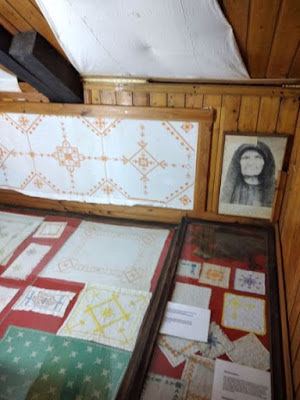In the mountainous village of Karya on the island of Lefkada you will find the Karya Folklore Museum (also known as Maria Koutsochero Folkore Museum) where its history is closely tied to the 'Karsaniki' stitch, a particular kind of embroidery art that is a rich tradition of the island.
It is housed in a traditional rural building from 1890 which was the residence of the 'Katopodi ' family.
The Folklore Museum was established on the initiative of Theodoros Katapodis, dance teacher of the Karyas 'O Apollon' Musicological Club, who gave the museum the name of 'Maria of Koutsochero', his mothers teacher.
In the museum you can admire the handmade embroidery with the famous 'Karsaniki stitch' handmade exhibits, several of them dated at the end of the 19th century as well as a collection of old objects and furniture, including the art of the loom and many objects and utensils of daily use exhibited in a space reminiscent of a traditional house of the mountainous Lefkas.
Examples of this craft show incredible perfection, not being able to distinguish the front or reverse of the stitching. Women would sit by candlelight or in the outdoor shade with the linen draped over one knee.
There are a variety of samplers in various colours available to purchase from the Folklore Museum. I chose to frame mine.
Maria's Story.
Maria Stavraka nicknamed Maria 'Koutsochero' was born in Karya Lefkada in the 1860's. At ten years of age Maria fell from a tree injuring her right arm. The scarce medical resources at the time forced the doctors to amputate Maria's arm. The young Maria learnt to embroider using only one hand, resting the worked fabric on her knee and began to stitch embroideries with art things she saw in fields, such as birds, leaves, flowers trees etc, creating the Karsaniki stitch.
The village was slow to accept her as a teacher however this perspective dis not last long as over time no villager could deny the great talent of 'Koutsochero.
In 1915 Zoe Valaoritis, sister in law to the famous Greek poet Aristotal Valaoritis, visited Maria and was in ore of the grandeur of her art. Along with Queen Sofia, a handicraft school was founded which was named 'progress' where many girls in the village were taught the art of embroidery (one handed also)
Maria Stavraka the 'Koutsochero' taught at the school until her death in 1948.
A few years later the 'Royal Welfare' gifted the women with threads and fabrics that were required for the creation of their embroideries thus providing the local women with an income.
Today the technique of the 'Karsaniki' has considerably reduced as only the oldest women continue the art of embroidery.
The embroidery designs are often worked into table linens, scarves and now jewelry pendants and handbags.
Things are Changing
I recently attended a group at Karya Cultural Association (situated in the old village school, behind the village church clock tower) who are encouraging anyone to take up the craft.
The group meets Mondays, Thursdays and Sundays at 5 - 6.30pm. Parking available.
Barbara, Anthi, Sevasti, and Aggiliki all gave a warm welcome. The age group is varied.
I was given a shopping list to take to the haberdashery shop (opposite the bus stop in central Lefkada) to purchase the items needed to start this craft.
Everyone is at a different stage of learning. Some work by coping the designed of an old family piece of work, others from paper templates and there is plenty of support.
The aim is not only to expose this unique art form but also to pass it on to younger generations, so that the 'Karsaniki' technique of unique beauty will be maintained in the future.
Below are a few interesting photos of the memorabilia inside of the Karya Cultural Association building.
See the link below for a more in-depth visit to the Karya Folklore Museum.
https://greekcountryliving.blogspot.com/2021/06/folklore-museum-karya-lefkada.html































Comments
Post a Comment